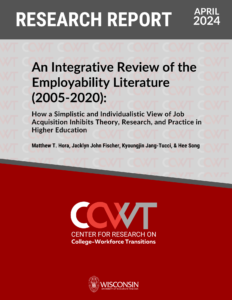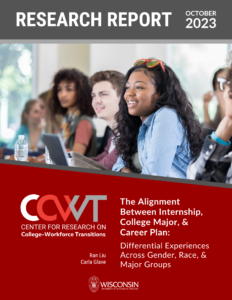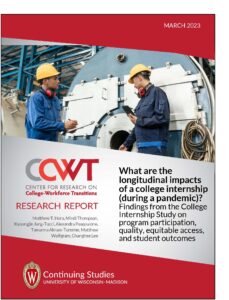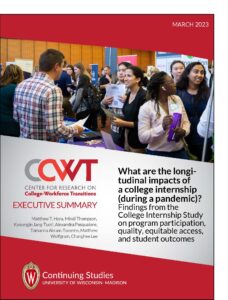Filter by Category:
Search
Year
- Category: Research Reports
- Clear Filters
Hora, M.T., John Fischer, J., Jang-Tucci, K., & Song, H. (2024). An integrative review of the employability literature (2005-2020): How a simplistic and individualistic view of job acquisition inhibits theory, research, and practice in higher education. Center for Research on College-Workforce Transitions. University of Wisconsin–Madison, Division of Continuing Studies. 
Abstract: The term “employability” (and its close cousin career readiness) is an idea that is playing an outsized role in shaping the future of global higher education in the early 21st century. In this paper the authors report findings from a critical, integrative review of the conceptual and empirical research on employability, where the primary aim was to evaluate whether recent scholarship has addressed long-standing critiques of the concept. These critiques include its tendency to be used as an ill-defined buzzword, an over-reliance on human capital theory, simplistic views on how people get jobs that over-emphasize skills and overlook structural forces, and ambiguous and/or evidence-free recommendations for campus practitioners. Thus, it is possible that a contested and poorly conceptualized and operationalized concept is driving a considerable amount of educational practice and policymaking in higher education – a hugely
problematic proposition.
The paper calls for scholars to reject the term “employability” in favor of “employment prospects,” as it underscores how job acquisition involves a complex array of both “supply” (e.g., individual student KSAs) and “demand” (e.g., labor market conditions, global pandemics) factors, and how an individuals’ prospects are not solely based on merit but are also shaped and constrained by the structural inequality. It also offers seven methodological questions that future scholars should consider when designing studies of graduates’ employment prospects: varying perspectives on causality, alternatives to human capital theory, methods for capturing multi-dimensional phenomena, the need to foreground student and worker voices and interests, how to engage in translational research, and considerations for framing research that does not solely position the purpose of higher education as a financial return on investment but also as an endeavor to benefit the common good.
Keywords: employability, higher education, career readiness, internships, skills, college-workforce transitions, labor market, workforce development, critical studies, multi-dimensional research.
Liu, R., & Glave, C. (2023). The Alignment Between Internship, College Major, & Career Plan: Differential Experiences Across Gender, Race, & Major Groups. Center for Research on College-Workforce Transitions. University of Wisconsin–Madison, Division of Continuing Studies.
Abstract:  This study proposes a novel tripartite alignment framework for internship studies to investigate alignment among student internship experiences, academic training in major programs, and career plans. Utilizing data from the College Internship Study, we examine demographic and programmatic factors associated with internship-major and internship-career alignment, and how these factors interact to affect overall internship satisfaction. While most students perceive their internships as relevant to their academic programs and career plans, a non-negligible group of students experience internship-major and internship-career misalignment, and the levels of misalignment vary across gender, race, major programs as well as their intersections. In particular, women engaged in paid internships report a lower level of internship-major alignment than women in unpaid internships, while this adverse effect is not found for men, indicating a potentially gendered trade-off between financial gains and academic training when making internship decisions. Moreover, while White students in health majors experience relatively higher internship-major alignment than business students, the same does not hold for Black and Latinx students, highlighting potential disparities in accessing quality internship programs in health sectors. Analyses further demonstrate that internship-major and internship-career alignment are positively associated with overall internship satisfaction. These findings provide preliminary insights into the tripartite internship-major-career alignment and its implications for students’ internship experiences, informing potential strategies for diversifying the workforce and enhancing school-to-work transitions. We discuss future research directions adopting this novel framework.
This study proposes a novel tripartite alignment framework for internship studies to investigate alignment among student internship experiences, academic training in major programs, and career plans. Utilizing data from the College Internship Study, we examine demographic and programmatic factors associated with internship-major and internship-career alignment, and how these factors interact to affect overall internship satisfaction. While most students perceive their internships as relevant to their academic programs and career plans, a non-negligible group of students experience internship-major and internship-career misalignment, and the levels of misalignment vary across gender, race, major programs as well as their intersections. In particular, women engaged in paid internships report a lower level of internship-major alignment than women in unpaid internships, while this adverse effect is not found for men, indicating a potentially gendered trade-off between financial gains and academic training when making internship decisions. Moreover, while White students in health majors experience relatively higher internship-major alignment than business students, the same does not hold for Black and Latinx students, highlighting potential disparities in accessing quality internship programs in health sectors. Analyses further demonstrate that internship-major and internship-career alignment are positively associated with overall internship satisfaction. These findings provide preliminary insights into the tripartite internship-major-career alignment and its implications for students’ internship experiences, informing potential strategies for diversifying the workforce and enhancing school-to-work transitions. We discuss future research directions adopting this novel framework.
Keywords: Internship, horizontal match, career development, school-to-work transition
Hora, M., Lee, C. (2023).  Cultural Scripts for Teaching Transferable Skills: Exploring the Role of Industry Experience and Pedagogical Situations on Skills-Focused Instruction in College Classrooms. Center for Research on College-Workforce Transitions. University of Wisconsin–Madison, Division of Continuing Studies.
Cultural Scripts for Teaching Transferable Skills: Exploring the Role of Industry Experience and Pedagogical Situations on Skills-Focused Instruction in College Classrooms. Center for Research on College-Workforce Transitions. University of Wisconsin–Madison, Division of Continuing Studies.
Abstract: Why do postsecondary faculty teach the way they do, and what predicts their use of particular teaching methods and student engagement strategies in the classroom? Based on research over the last 40 years in both K-12 and postsecondary settings, consensus exists that no single predictor of instructional practice exists, but that a myriad of forces (e.g., individual, socio-cultural, and contextual) interact to shape how an instructor plans and teaches their classes (Shavelson & Stern, 1981; Lattuca & Stark, 2011; Posselt et al., 2020).
In this paper, we address this question by examining the potential role of a specific type of instructor attribute – that of prior experience in non-academic workplaces (hereafter called industry experience) – that is theorized to be associated with students’ acquisition of skills known variously as “soft,” “non-cognitive” or “transferable” (Deming, 2017; Pellegrino & Hilton, 2002). We address how culture is conceptualized in higher education in general, and in studies of faculty teaching in particular, especially the unit of analysis wherein cultural elements reside and then change (or not) over time (Välimaa, 1998). Following a brief exposition of the theoretical and empirical foundations of this approach, we then report findings from an exploratory mixed-methods study where these ideas were explored in the context of teaching in science, technology, engineering, mathematics and medical (STEMM) fields. We conclude the paper with an analysis of the implications of these data for faculty development, but also concerns that cultural scripts can encode ideologies and norms antithetical to a liberal, democratic, and equity-oriented education (Cronon, 1988; Harris & Patton, 2019; Urciuoli, 2008).

Hora M.T., Thompson M., Jang-Tucci K., Pasqualone A., Akram-Turenne T., Wolfgram M., Lee C. (2023). What are the longitudinal impacts of a college internship (during a pandemic)? Findings from the College Internship Study on program participation, quality, equitable access, and student outcomes. Center for Research on College-Workforce Transitions. University of Wisconsin–Madison, Division of Continuing Studies.

Abstract: The College Internship Study wrapped up its third and final wave of data collection in the Spring of 2022. This report provides a summary of key findings from the longitudinal analyses across eight institutions that participated in the third and final wave of data collection. As an excerpt of the extensive dataset, this summary addresses the most pressing issues in college internship research and practice, as suggested in the Internship Scorecard (Hora et al., 2020). Developed for assessing the purpose, quality, and equity of internship programs, the Internship Scorecard provides a framework for this report to address three main issues of college internships: (a) access and barriers to internships, (b) internship program features and quality, and (c) effects of internships on post-graduate outcomes. Each of these issues are examined in this report, with special considerations for how the COVID-19 pandemic impacted student experiences in college, life, and work.
